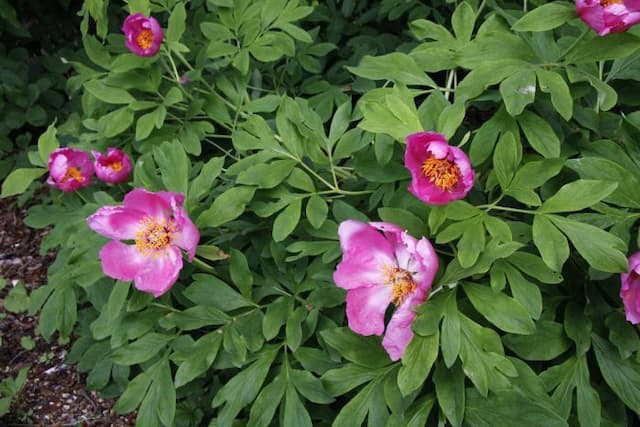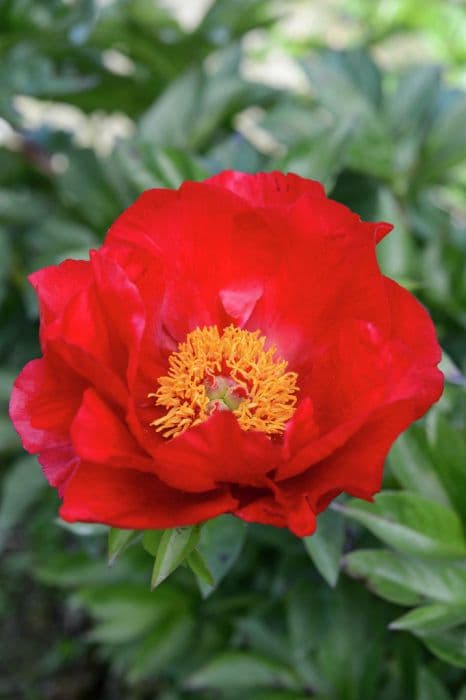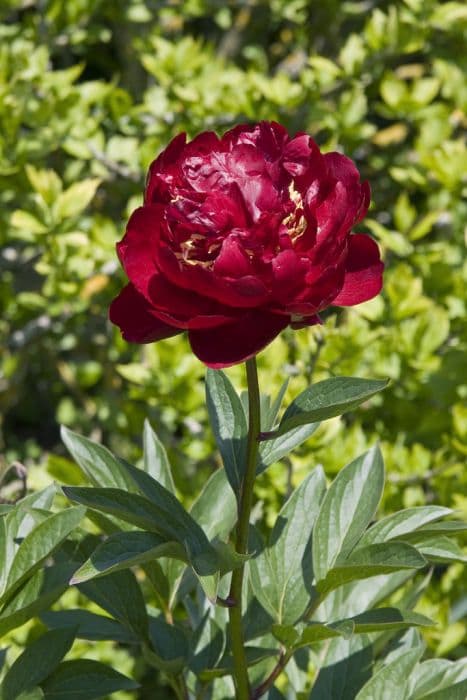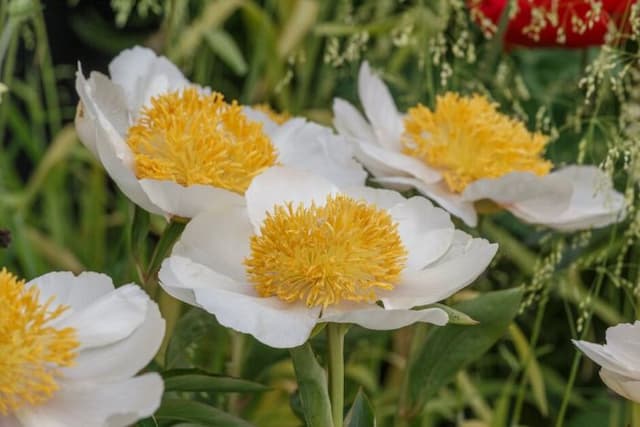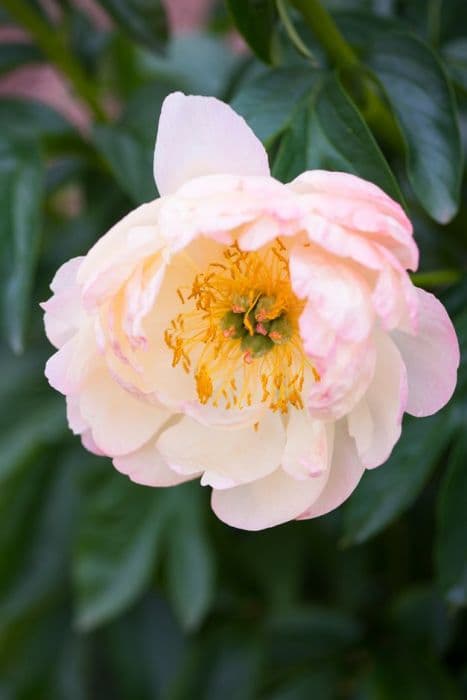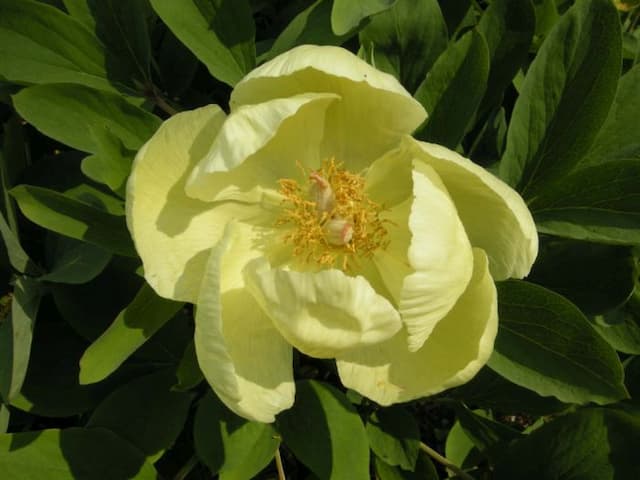Peony Paeonia lactiflora 'The Fawn'

ABOUT
The Fawn is a variety of peony known for its distinctive flowers and attractive foliage. The flowers are a soft pink color with a unique pattern resembling the spots of a fawn, giving this plant its name. These blossoms are large and double-formed, with multiple layers of ruffled petals. The outer petals often appear lighter in shade, giving a delicate, ethereal effect that contrasts with the deeper pink markings. The plant itself has a bushy form, with deep green leaves that provide a lush backdrop for the blooms. The foliage is divided into leaflets that are oval-shaped and have a smooth texture. This peony variety exudes a light, sweet fragrance that can be noticed when in close proximity to the flowers. The plant blooms in late spring to early summer, providing a showy display that adds romance and old-world charm to any garden setting. Despite the absence of specific measurements, The Fawn is known for its striking visual presence and the grace it brings to ornamental gardens.
About this plant
 Names
NamesFamily
Paeoniaceae
Synonyms
Chinese Peony, White Peony
Common names
Paeonia lactiflora 'The Fawn'.
 Toxicity
ToxicityTo humans
Peony, specifically Paeonia lactiflora 'The Fawn', is generally considered to have low toxicity to humans. Ingesting any part of the plant is not commonly associated with severe poisoning. However, some individuals may be sensitive and could potentially experience mild gastrointestinal upset such as nausea, vomiting, or diarrhea after consuming parts of the plant.
To pets
Peony, including the variety Paeonia lactiflora 'The Fawn', is also considered to have low toxicity to pets such as dogs and cats. It is not known to be highly poisonous, but if ingested in large quantities, it could potentially cause mild gastrointestinal discomfort, which could result in symptoms like vomiting and diarrhea. It's always a good idea to keep an eye on your pet and consult with a veterinarian if you suspect they have ingested any part of a peony plant.
 Characteristics
CharacteristicsLife cycle
Perennials
Foliage type
Deciduous
Color of leaves
Green
Flower color
Pink
Height
2-3 feet (60-90 cm)
Spread
2-3 feet (60-90 cm)
Plant type
Herb
Hardiness zones
3-8
Native area
Asia
Benefits
 General Benefits
General Benefits- Ornamental Appeal: The Fawn peony offers striking blooms with a unique, dappled pattern that adds visual interest to gardens and landscapes.
- Garden Ecosystem Support: By attracting pollinators such as bees and butterflies, it helps to sustain the local ecosystem.
- Seasonal Interest: This peony provides a burst of spring color when it flowers, adding to the aesthetic appeal of gardens during this season.
- Low Maintenance: Once established, The Fawn peony is relatively low maintenance, requiring minimal care beyond occasional watering and feeding.
- Longevity: Peonies are known for their long life span. With proper care, they can thrive for decades, providing long-term value for a garden.
- Cut Flowers: The blooms are suitable for cutting and can create beautiful indoor floral arrangements, extending the enjoyment beyond the garden.
- Drought Tolerance: Once established, peonies like The Fawn can tolerate periods of drought, making them suitable for gardens with varying water availability.
- Cold Hardy: Peonies are resilient in cold temperatures and can survive harsh winters, making them a valuable addition to gardens in cooler climates.
- Improves Soil Health: As a perennial, The Fawn peony helps to stabilize soil and can improve its overall health through its root system.
- Heritage and History: Peonies have a long history of cultivation and can add a sense of tradition and heritage to gardens.
 Medical Properties
Medical Properties- Anti-inflammatory: Paeonia lactiflora, commonly known as white peony, has been used in traditional medicine for its potential anti-inflammatory properties.
- Analgesic: The root of white peony may have pain-relieving effects.
- Immunomodulatory: It may modulate the immune system, potentially beneficial in treating autoimmune disorders.
- Antispasmodic: The herb is used in traditional medicine to help relieve muscle spasms.
- Antioxidant: White peony may contain compounds that have antioxidant effects.
- Neuroprotective: There is some evidence to suggest that white peony might have protective effects on the nervous system.
- Circulatory health: Traditionally, it has been used to support healthy blood circulation.
- Hepatoprotective: Some studies suggest that white peony could help protect the liver from damage.
 Air-purifying Qualities
Air-purifying QualitiesThis plant is not specifically known for air purifying qualities.
 Other Uses
Other Uses- Artistic inspiration: The distinct speckled petals of 'The Fawn' peony have inspired patterns in fashion design, textile prints, and even jewelry items.
- Garden Photography: Its unique appearance makes 'The Fawn' peony a popular subject for garden photographers and photo contests, seeking to capture its distinctive beauty.
- Culinary Garnish: While not a common practice, the petals of 'The Fawn' peony can be used as an edible garnish for desserts and salads in high-end culinary presentations.
- Wedding Decor: The elegant flowers of 'The Fawn' peony are used in bridal bouquets and as centerpieces for weddings due to their romantic appearance and symbolism of happiness.
- Ecosystem Support: 'The Fawn' peony can be planted to support local ecosystems by providing pollen for bees and other pollinators during their blooming season.
- Herbal Teas: Some homeowners use the petals cautiously in homemade herbal teas for their fragrance, although culinary use is not a primary purpose of this plant.
- Education: Botanical gardens and educational institutions may use 'The Fawn' peony as a specimen for teaching botany and horticulture, showcasing plant variation and hybridization.
- Crafts: Dried petals of 'The Fawn' peony are occasionally used in crafting, such as in making natural potpourri or for inclusion in handmade paper.
- Color Inspiration: Artists and interior designers sometimes use 'The Fawn' peony as a muse for color palettes, drawing on its pastel pinks and unique patterns for visual projects.
- Perfumery: Occasionally, the scent of 'The Fawn' peony may be analyzed and replicated in the creation of perfumes and scented products, seeking to capture its light floral aroma.
Interesting Facts
 Feng Shui
Feng ShuiThe Peony is not used in Feng Shui practice.
 Zodiac Sign Compitability
Zodiac Sign CompitabilityThe Peony is not used in astrology practice.
 Plant Symbolism
Plant Symbolism- Beauty - The gorgeous and intricate blooms of the Paeonia lactiflora, commonly known as the Peony 'The Fawn', are often associated with the ideal of beauty in various cultures.
- Prosperity - Peonies are traditionally seen as symbols of wealth and prosperity, due to their full, rounded blossoms.
- Romance - With their lush, full petals, peonies like 'The Fawn' are often tied to romantic love and sometimes used in wedding bouquets.
- Honor - In some contexts, the peony represents honor and high value, as they are considered regal flowers with a luxurious appearance.
 Water
WaterPeonies, including 'The Fawn', require consistent moisture, particularly during the growing season in spring and early summer. Water peonies deeply once a week, providing about one inch of water each time, which equates to roughly 0.623 gallons per square foot. During periods of drought or extreme heat, you may need to water twice a week. It’s vital to avoid overhead watering to prevent fungal diseases; instead, apply water directly to the soil at the base of the plant. Keep the soil moist but not waterlogged, as peonies do not like to sit in water.
 Light
LightPeonies like 'The Fawn' flourish in full sun conditions, receiving at least six to eight hours of direct sunlight daily. The ideal spot for planting peonies is in an area that enjoys morning sunlight and possibly partial shade during the harshest afternoon hours to protect blooms from fading. However, too much shade can result in fewer blooms and weaker stems, so ensure adequate light for optimal growth.
 Temperature
Temperature'The Fawn' peony is tolerant of a wide range of temperatures but grows best when spring daytime temperatures are between 65°F and 75°F. They can survive winter cold down to approximately -20°F, but for best flowering, they require a period of winter chill between 32°F and 40°F. Peonies are cold hardy and need the cold period to reset their blooming cycle for the following spring.
 Pruning
PruningPrune 'The Fawn' peony after it blooms by deadheading spent flowers to encourage healthy growth and potentially additional blooms. In the fall, cut the peony stems down to within a few inches of the ground to prepare for winter and prevent overwintering diseases. Pruning helps maintain an attractive shape and ensures the plant allocates resources to developing strong roots and blooms for the next season.
 Cleaning
CleaningAs needed
 Soil
SoilPeony 'The Fawn' thrives in fertile, well-draining soil with a pH of 6.5 to 7.5. A good soil mix for this plant would be equal parts garden soil, compost, and perlite or sand to ensure proper drainage. Regularly amending the soil with organic matter will promote healthy growth.
 Repotting
RepottingPeony 'The Fawn' is typically grown in the ground and does not require frequent repotting. If grown in containers, they should be repotted when rootbound, approximately every 3 to 4 years, into a slightly larger pot to ensure continued growth.
 Humidity & Misting
Humidity & MistingPeony 'The Fawn' prefers average humidity levels found in most outdoor garden settings and does not require special humidity conditions. They are well-adapted to the ambient humidity levels of temperate climates.
 Suitable locations
Suitable locationsIndoor
Grow Peony 'The Fawn' by a sunny window and ensure good air circulation.
Outdoor
Plant Peony 'The Fawn' in full sun, well-drained soil, and water regularly.
Hardiness zone
3-8 USDA
 Life cycle
Life cyclePaeonia lactiflora 'The Fawn', commonly known as the Chinese Peony or 'The Fawn' Peony, begins its life cycle as a dormant tuberous root system planted in autumn. When spring arrives, the roots send up shoots which develop into stems and foliage, relying on stored energy within the tuber. By late spring to early summer, the plant reaches its flowering stage, producing large, fragrant pink blossoms dappled with fawn-like spots, a characteristic from which its name is derived. After pollination, often by insects, the plant may produce seeds in pod-like structures that, if viable, can be dispersed to generate new plants. As the growing season ends, the plant's above-ground foliage dies back and the peony enters a period of dormancy throughout the winter, conserving energy in the root system once again. Each following spring, the perennial cycle repeats, with the plant emerging from dormancy to grow, bloom, and eventually return to dormancy in a continuous yearly rhythm.
 Propogation
PropogationPropogation time
Spring-Early Summer
Paeonia lactiflora 'The Fawn', commonly known as Peony 'The Fawn', is typically propagated by division, which is the most popular method. The best time for dividing peonies is in the fall when the plants have gone dormant, approximately after the first killing frost. To propagate by division, dig up the peony clump ensuring a good-sized root ball is intact. The root clump should be divided into sections with a sharp knife, making sure that each division has at least three to five eyes, which are the potential growth points. The eyes should be pointing upwards when you replant the divisions. Plant the divided clumps so that the eyes are about 2 inches deep (5 cm) in northern climates and 1 inch deep (2.5 cm) in warmer climates to ensure proper development. Provide the divisions with well-drained soil and full sun exposure to encourage successful growth.
